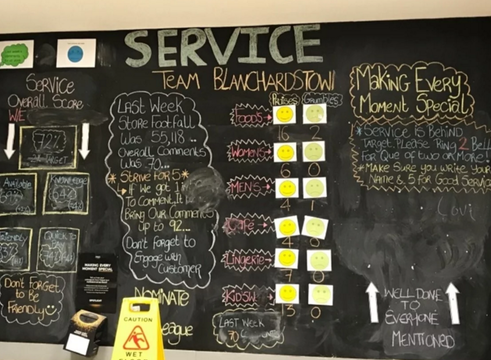I recently visited an outlet of a multinational department store where the emergency exit was in use due to some maintenance being done on an escalator. I was delighted to see the blackboard below covering an entire wall in what would normally be a staff only area. This kind of initiative is commendable and no doubt it has helped the brand build its reputation for being very customer-centric.
Image Source: Service Dock
However, while commendable, this initiative has fallen into the trap of focusing too heavily on quantitative feedback. Net Promoter (NPS) and Customer Satisfaction (CSAT) scores are easy to digest, compare and track over time. They serve as great benchmarking tools and indicators of performance. That is why they were created and have become so popular. Most businesses use them by linking bonuses and incentives to them, which can be effective at motivating staff to improve their performance in terms of customer service. But ultimately NPS, CSAT and other metrics are just numbers. They are soulless statistics that don’t speak to a human’s most powerful influence. Emotions!
Using Emotions to Improve NPS in Brick-and-Mortar Businesses
Your customers’ emotions are not found in the ratings they give your staff. They are found in the qualitative feedback that you should be collecting alongside those ratings. Unfortunately, this feedback is not as straightforward to put to work as quantitative data. A business may respond to specific problems on a one-to-one basis or use a word cloud to identify recurring issues, but that is often the extent to which they use it.
They are not mining the golden nuggets that are to be found throughout freeform feedback. These nuggets are your customer’s stories, and they hold the key to motivating your team to outperform in terms of CX and increase NPS. It takes time and effort to identify the stories that will have the most impact, but that will be time well spent if you put those stories to use properly.
How Customer Stories Make NPS More Impactful
The primary objective of using stories is to make metrics like NPS more human. You are trying to put faces to the scores to arouse certain emotions in your employees. Those emotions will change depending on whether the stories are positive or negative.
Positive Customer Stories
The emotions you’re looking to elicit from your staff with positive stories include pride, joy and surprise. Take, for example, a case where an elderly gentleman has expressed his gratitude to a staff member for bringing his shopping bags to his car. Many of your staff will have an elderly father or grandfather that will help them relate to this story. Placing this information alongside your promoter number, or whatever other metric you’re using, creates a much more powerful motivator than the number alone.
Publicly naming individuals might be a good idea with positive feedback, as long as you spread the praise around the team. This allows the rest of the team to celebrate the individual’s contribution and make the impact of great customer service more tangible.
Negative Customer Stories
There is a serious risk that detractors are equated to whiners unless your staff can relate to the people and the experiences behind low ratings. Here the emotions that will have the most impact are anger, fear and maybe even a little shame. You’re looking for stories like a young mother reporting how distressed she was at the way she was told to move her pram in a cafe. Again, most of your staff will be able to relate to this situation, either through personal experience or a close friend or relation. You want to hammer home how your staff’s actions and/or inactions can deeply affect other human beings. You want them to be considerate, empathetic and all the other good things that great customer service teams possess.
It will rarely be useful to publicly name individuals in relation to negative feedback. By all means take the person aside, but publicly naming runs the risk of arousing emotions like humiliation and embarrassment which are rarely productive.
Take Some Small Steps to Get Started
Ultimately what you’re trying to do is make your NPS number richer for your team. Whatever way you communicate your customer experience stats to them, it can’t just be “we’re on 50 and we want to get to 65”.
Whether you’re using a blackboard like the above store or you’ve got an online tool, try adding a section entitled “Things we’re doing right” alongside your promoter number and “Things we can improve” beside your detractor number. The greater the emotional impact of the stories, the greater the chance you will achieve a meaningful improvement in your NPS score.
Numbers won’t always inspire staff… knowing they’re making a difference to other people will.
Author: Oisin Ryan
Founder and CEO of ServiceDock, which is a SaaS platform that leverages messaging apps to help multi-location businesses capture feedback and engage customers at store-level while delivering data and insights to head office. Areas of expertise include business to consumer messaging, customer experience and customer service software.



